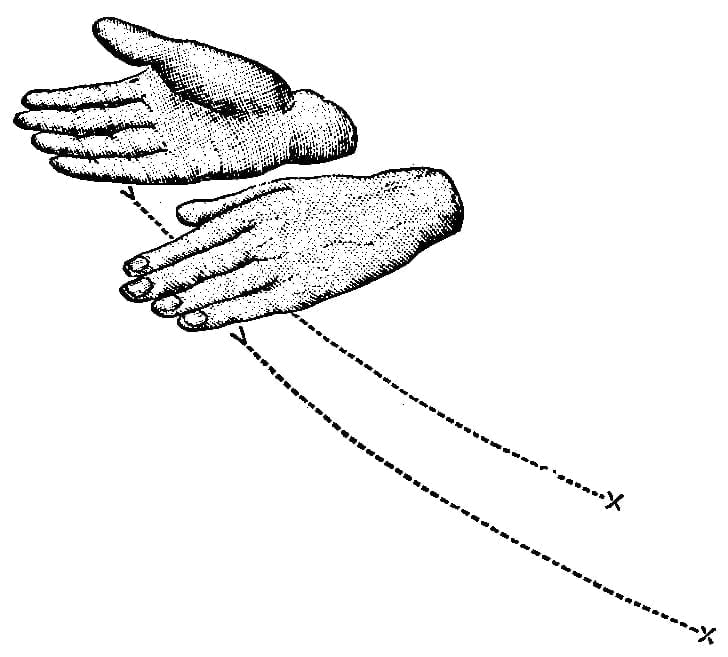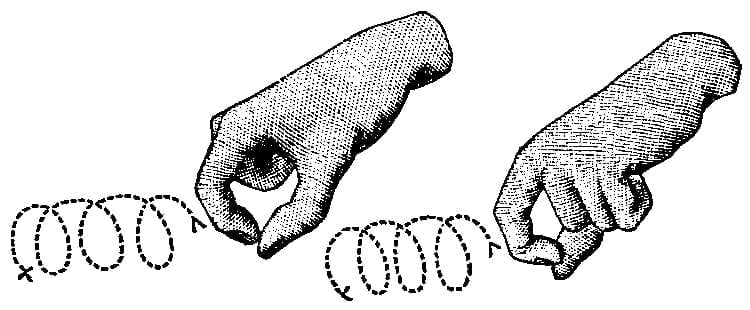The following statement was made to Dr. W.J. Hoffman by Tso-di-a’-ko (Shaved-head Boy), chief of the Wichitas in Indian Territory, while on a visit to Washington, D.C., in June 1880.
The Indian being asked whether there was any timber in his part of the Territory, replied in signs as follows: (1) Move the right hand, fingers loosely extended, separated and pointing upward, back to the front, upward from the height of the waist to the front of the face – tree (for illustration see Fig. 112, p. 343); repeat this two or three timestrees; (2) then hold the hand, fingers extended and joined, pointing upward, with the back to the front, and push it forward toward different points on a level with the face-standing at various places; (3) both hands, with spread and slightly curved fingers, are held about two feet apart, before the thighs, palms facing, then draw them toward one another horizontally and gradually upward until the wrists cross, as if grasping a bunch of grass and pulling it up – many; (4) point to the southwest with the index, elevating it a little above the horizon – country; (5) then throw the fist edgewise toward the surface, in that direction – my, mine; (6) place both hands, extended, flat, edgewise before the body, the left below the right, and both edges pointing toward the ground a short distance to the left of the body, then make repeated cuts toward that direction from different points, the termination of each cut ending at nearly the same point – cut down, Fig. 326;

(7) hold the left hand with the fingers and thumb collected to a point, directed horizontally forward, and make several cutting motions with the edge of the flat right hand transversely by the tips of the left, and upon the wrist – cut off the ends; (8) then cut upon the left hand, still held in the same position, with the right, the cuts being parallel to the longitudinal axis of the palmsplit; (9) both hands closed in front of the body, about four inches apart, with forefingers and thumbs approximating half circles, palms toward the ground, move them forward so that the back of the hand comes forward and the half circles imitate the movement of wheels – wagon, Fig. 327;

(10) hold the left flat hand before the body, pointing horizontally forward, with the palm down, then bring the right flat hand from the right side and slap the palm upon the back of the left several times – load, upon, Fig. 328; (11) partly close the right hand as if grasping a thick rod, palm toward the ground, and push it straight forward nearly to arm’s length – take; (12) hold both hands with fingers naturally extended and slightly separated nearly at arm’s length before the body, palms down, the right lying upon the left, then pass the upper forward and downward from the left quickly, so that the wrist of the right is raised and the fingers point earthward – throw off; (13) cut the left palm repeatedly with the outer edge of the extended right hand – build; (14) hold both hands edgewise before the body, palms facing, spread the fingers and place those of one hand into the spaces between those of the left, so that the tips of one protrude beyond the backs of the fingers of the other – log house, see Fig. 253, p. 428; (15) then place the flat right hand, palm down and fingers pointing to the left, against the breast and move it forward, and slightly upward and to the right – good.

ANALYSIS OF THE FOREGOING.
| [There is] much | timber | [in] my | country | [of which I] | cut down | ||||||||||
| (3) | (1,2) | (5) | (4) | (6) | |||||||||||
| [some] | trimmed, | split, | loaded it upon | a wagon | [and] | took it away, | |||||||||
| (7) | (8) | (10) | (9) | (11) | |||||||||||
| [where I] | threw [it] off | [and] built | [a] good | house . | |||||||||||
| (12) | (13) | (15) | (14) | ||||||||||||
Notes. – As will be seen, the word timber is composed of signs No. 1 and 2, signifying trees standing. Sign No. 3, for many, in this instance, as in similar other examples, becomes much. The word “in,” in connection with country and my, is expressed by the gesture of pointing (passing the hand less quickly than in ordinary sign language) before making sign No. 5. That sign commonly given for possession, would, without the prefix of indication, imply my country, and with that prefix signifies in my country. Sign No. 7, trimmed, is indicated by chopping off the ends, and facial expression denoting satisfaction. In sign Nos. 11 and 12 the gestures were continuous, but at the termination of the latter the narrator straightened himself somewhat, denoting that he had overcome the greater part of the labor. Sign No. 14 denotes log-house, from the manner of interlacing the finger-ends, thus representing the corner of a log-house, and the arrangement of the ends of the same. Indian lodge would be indicated by another sign, although the latter is often used as an abbreviation for the former, when the subject of conversation is known to all present.

